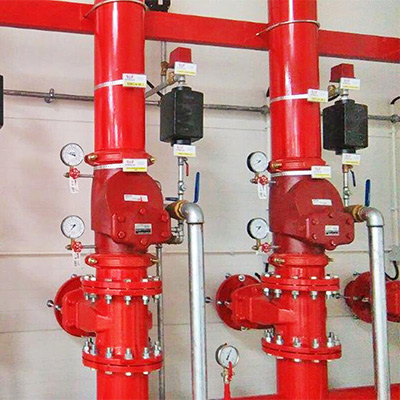Basic principles of operation
Fire sprinkler systems are an integral part of fire protection systems in modern buildings. They provide effective protection against fire, minimizing the risk of material and human losses. In this article, we will discuss the basic principles of operation of fire sprinkler systems and their key elements.
What is a fire sprinkler system?
A sprinkler fire protection system is an automatic fire protection system that consists of a network of pipes, each of which is equipped with a fire sprinkler. Sprinklers, which are the sensing elements of the system, are designed to detect and extinguish a fire at an early stage, before the fire brigade arrives.
Sprinkler Operation Principles
Sprinklers operate on the principle of thermal activation. Each sprinkler is equipped with a thermal sensor that responds to an increase in ambient temperature. When the temperature exceeds a threshold value, usually 68°C, the sensor is destroyed and the sprinkler begins to spray water onto the fire.

Types of Sprinklers
There are several types of sprinklers that differ in their parameters and applications:
- Wet pipe sprinklers – the most common type, in which water is constantly present in the pipes. If a fire is detected, water is immediately sprayed through the activated sprinklers.
- Dry pipe sprinklers – used in low temperature facilities where freezing of water in pipes is possible. This system is filled with air or gas, and the water supply is controlled by a controlled valve.
- Pre-action sprinklers – use electric smoke sensors that activate a valve, releasing water into the system. They are used in areas with a higher risk of false alarms.
Key components of a fire sprinkler system
- Water Supply Source: The system must be supplied by a reliable water source such as a municipal water supply, a holding tank, or a well. It is important to provide adequate water pressure and flow for the sprinklers to operate effectively.
- Valves: Valves control the flow of water in a system. An alarm valve allows you to detect water flow in the system, signaling the activation of sprinklers. Shut-off valves allow you to isolate individual parts of the system during maintenance or failure.
- Pipelines: Pipes are designed to carry water to individual sprinklers. They must be made of corrosion-resistant materials, and their diameter and length affect the pressure and flow of water in the system.
- Smoke and Flame Sensors: Some systems, such as pre-action sprinklers, use additional smoke or flame sensors. These are used to provide early fire detection and activate sprinklers before they are thermally activated.
Fire Sprinkler System Maintenance and Inspection
Regular maintenance and inspection of the fire sprinkler system is essential to maintain its efficiency and effectiveness. Inspections should be carried out to check the condition of sprinklers, pipes, valves and sensors, and pressure and flow tests should be carried out. In addition, fire protection regulations and manufacturer’s recommendations must be followed.
Summary
Sprinkler systems are a key element of fire protection in buildings. They provide effective protection against fires, minimizing the risk of property and human losses. Understanding the basic principles of sprinkler operation and their key components allows for more effective use of such systems and keeping them fully operational. Regular maintenance and inspection of the system is essential for maintaining reliability and safety of use.
